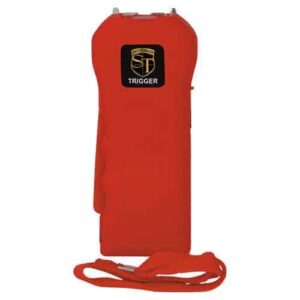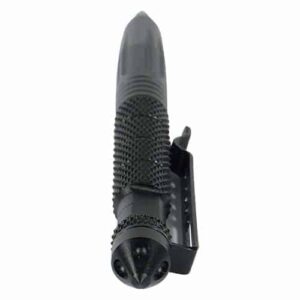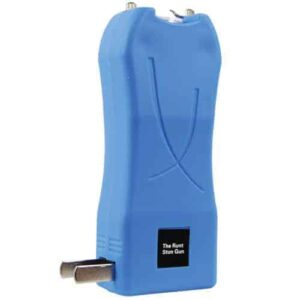If you’ve ever been curious about how to obtain Taser certification, look no further. This article will guide you through the process of becoming certified to carry and use a Taser device. From finding accredited training programs to learning the necessary skills and knowledge, you’ll discover everything you need to know to ensure your safety and the safety of others when handling this powerful non-lethal weapon. Whether you’re a law enforcement officer, security professional, or simply interested in self-defense, Taser certification is essential for responsible and effective use. So, let’s explore the steps to obtaining Taser certification together.
Table of Contents
ToggleWhy Obtain Taser Certification
The importance of proper training
Obtaining Taser certification is crucial for individuals who are interested in utilizing these devices for personal or professional use. Proper training ensures that you have the necessary knowledge and skills to handle a Taser safely and effectively. Without proper training, you may be putting yourself and others at risk of injury or legal repercussions. By obtaining Taser certification, you demonstrate your commitment to safety and responsible use of this self-defense tool.
Legal regulations and requirements
In many jurisdictions, the use of Taser devices is regulated, and individuals who wish to carry or use them may be required to obtain certification. This is to ensure that those who possess Tasers are aware of and adhere to the laws and regulations surrounding their use. By obtaining Taser certification, you not only meet legal requirements but also gain a comprehensive understanding of the legal implications and responsibilities associated with Taser usage. This knowledge can help protect you from potential legal pitfalls and ensure that you are using Tasers within the confines of the law.
Enhanced job prospects and opportunities
With Taser certification, you open up new job prospects and opportunities within various industries. Many security firms, law enforcement agencies, and private companies require their employees to be Taser certified. By obtaining certification, you become a more attractive candidate for these positions and increase your chances of securing employment in these fields. Taser certification can also enhance your marketability as a private security professional or self-defense instructor, as it demonstrates your expertise and commitment to safety.
Choosing a Taser Certification Program
Researching reputable training programs
When choosing a Taser certification program, it is essential to research and identify reputable training providers. Look for programs that have a proven track record of providing comprehensive and high-quality training. Read reviews and testimonials from past participants to get a sense of the program’s effectiveness and reputation. Additionally, consider reaching out to professionals in the industry for recommendations and guidance.
Considering certification agencies
Taser certification programs are often offered by specific certification agencies that have been authorized by the manufacturer. It is important to choose a program that is recognized and accredited by a reputable certification agency. This ensures that the training you receive meets industry standards and is recognized by employers and regulatory bodies. Look for certification agencies that have a strong reputation and are recognized within the security and law enforcement community.
Reviewing program curriculum and requirements
Each Taser certification program will have its own curriculum and requirements. It is crucial to review the program’s curriculum to ensure it covers all the necessary topics and provides comprehensive training. Look for programs that cover areas such as Taser safety, legal considerations, first aid training, and practical hands-on exercises. Additionally, review the program’s requirements to ensure that you meet any prerequisites or physical fitness criteria necessary to participate in the program.
Meeting Prerequisites
Age and legal requirements
Before enrolling in a Taser certification program, it is essential to check the age and legal requirements set by your jurisdiction. Different regions may have different age restrictions for individuals who wish to obtain Taser certification. Ensure that you meet the minimum age requirement before considering certification. Additionally, familiarize yourself with any other legal requirements, such as background checks or permits, that may be necessary to obtain certification in your area.
Background checks and criminal record
Some Taser certification programs may require background checks or request information about your criminal record. This ensures that individuals with a history of violent offenses or other disqualifying factors are not certified to handle Tasers. If you have concerns about your criminal record affecting your ability to obtain certification, it may be helpful to consult with the certification agency or program coordinator to discuss your specific circumstances.
Physical fitness and health conditions
Taser certification programs often involve physical activity and hands-on training. It is important to assess your physical fitness level and ensure that you are capable of participating in the program. Some programs may have specific physical fitness requirements, such as being able to run or engage in physical confrontations. Additionally, if you have any health conditions that may affect your ability to safely handle a Taser, it is essential to disclose this information to the program coordinators and seek their guidance on whether you can still participate in the training.
Training Course Overview
Classroom instruction
Taser certification programs typically include classroom instruction, where participants learn about the theory, concepts, and legal aspects of using a Taser. In the classroom setting, you can expect to receive detailed information about Taser safety protocols, proper handling techniques, and the legal rights and responsibilities associated with Taser usage. This theoretical knowledge forms the foundation for the practical training that follows.
Practical hands-on training
After completing the classroom instruction, Taser certification programs provide practical hands-on training. This training allows participants to gain firsthand experience in handling and deploying a Taser. Under the supervision of experienced instructors, you will learn how to properly hold and aim a Taser, understand the impact of the device on the target, and practice deploying it in various scenarios. This hands-on training is crucial for developing the muscle memory and confidence needed to use a Taser effectively.
Scenario-based training exercises
To further enhance your training, many certification programs incorporate scenario-based training exercises. These exercises simulate real-life situations that you may encounter while using a Taser. By practicing in controlled environments, you can develop your decision-making skills and learn how to assess threats and respond appropriately. Scenario-based training exercises provide a safe and controlled environment to apply your knowledge and skills, allowing for valuable learning experiences.
Taser Safety and Operations
Understanding Taser components and functions
Taser certification programs emphasize a thorough understanding of the device’s components and functions. This includes learning about the electrical circuitry, cartridge placement, and trigger mechanisms of a Taser. Understanding how a Taser operates enables you to troubleshoot potential issues and ensures that you can safely handle and operate the device.

Proper Taser handling and aiming
Proper handling and aiming of a Taser are critical for effective deployment. Taser certification programs teach participants how to hold, grip, and carry the device safely and securely. You will learn about proper hand positioning, trigger control, and reloading techniques. Additionally, instructors will guide you on how to aim the Taser accurately to maximize its effectiveness while minimizing the risk of collateral damage.
Safety precautions and protocols
Taser certification programs prioritize safety above all else. You will learn about important safety precautions and protocols to follow when handling a Taser. This includes understanding the recommended distance from targets, ensuring a clear line of sight, and minimizing the risk of accidental discharges. By following these safety precautions and protocols, you can mitigate the potential risks associated with Taser usage and ensure the safety of both yourself and others.
Legal Considerations
Understanding local laws and regulations
Taser certification programs provide comprehensive training on the legal considerations surrounding Taser usage. Participants gain an understanding of local laws and regulations governing the possession, use, and deployment of Tasers. This knowledge ensures that you are aware of the rights and limitations associated with Taser usage in your jurisdiction. By understanding the legal landscape, you can confidently use a Taser within the boundaries of the law.
Use of force policies
In addition to local laws, Taser certification programs educate participants on use of force policies. Different organizations and professions may have specific guidelines regarding the appropriate use of force, including when and how a Taser can be deployed. Understanding these policies is essential to ensure that you are using a Taser responsibly and within the guidelines set forth by your employer or regulatory body.
Legal consequences and liabilities
Using a Taser incorrectly or unlawfully can have severe legal consequences and liabilities. Taser certification programs cover the potential legal implications of misuse or abuse of the device. Participants learn about the possible criminal charges, civil lawsuits, and administrative penalties that may arise from improper Taser usage. By being well-informed about the legal consequences, you can make informed decisions and avoid actions that may result in legal entanglements.
First Aid and Medical Training
Recognizing signs of distress
Taser certification programs often include training on recognizing signs of distress in individuals who have been subjected to a Taser deployment. Participants will learn how to identify symptoms such as respiratory distress, chest pain, or loss of consciousness and know when to seek medical attention. This knowledge ensures that you can respond appropriately in the event of an adverse reaction to Taser usage.
Providing basic first aid
Basic first aid skills are invaluable when using a Taser. Certification programs provide training on how to administer basic first aid in situations where Taser deployment has resulted in injury or distress. Participants will learn how to apply basic wound care, control bleeding, and respond to medical emergencies. By having these skills, you can provide immediate assistance to those in need while waiting for professional medical help.
Emergency medical response
Taser certification programs may also include training in emergency medical response. Participants learn about the appropriate procedures to follow in the event of a serious injury or medical emergency. This training ensures that you can quickly and effectively communicate with emergency medical services and provide accurate information about the situation. By understanding how to respond in an emergency, you can help facilitate a prompt and appropriate medical response.
Written Examinations
Reviewing course material
To assess your understanding and knowledge, most Taser certification programs require written examinations. These exams typically cover the material presented during the classroom instruction phase. To prepare for these exams, it is essential to review the course material thoroughly. Take notes during the classroom sessions, create study guides, and revisit any areas that you find challenging. By reviewing the course material, you can consolidate your knowledge and improve your performance on the written examinations.
Preparing for written assessments
Preparing for written assessments involves more than just reviewing course material. It is essential to practice answering sample questions and familiarize yourself with the format and structure of the exam. Some Taser certification programs may provide practice exams or study guides to assist in your preparation. Additionally, consider forming study groups or seeking clarification from instructors on any concepts that you find confusing. Adequate preparation will boost your confidence and increase your chances of success on the written assessments.
Tips for successful exam performance
On the day of the written examinations, it is crucial to manage your time effectively and remain calm. Read each question carefully and ensure that you understand what is being asked before providing your answer. Take your time to think through each question and draw upon your knowledge and understanding of the course material. If you encounter challenging questions, do not panic. Skip them momentarily and come back to them later. By staying focused and composed, you can optimize your exam performance and demonstrate your mastery of the Taser certification material.
Practical Performance Evaluation
Demonstrating proper Taser usage
The practical performance evaluation is a key component of Taser certification. This evaluation assesses your ability to handle and deploy a Taser correctly. Under the guidance and supervision of instructors, you will be required to demonstrate proper Taser handling techniques, accurate aiming, and effective deployment. It is important to practice regularly and follow the guidance provided during the training program to ensure that you can perform these tasks confidently and proficiently.
Conducting scenario-based simulations
Scenario-based simulations are commonly used in the practical evaluation to assess participants’ ability to make sound judgment calls while using a Taser. These simulations aim to recreate real-life situations where individuals may need to use a Taser to protect themselves or others. By participating in scenario-based simulations, you can practice applying your knowledge and skills in dynamic and unpredictable environments, further enhancing your ability to respond appropriately in different situations.
Evaluating situational decision-making
During the practical performance evaluation, evaluators will assess your situational decision-making skills. This includes assessing your ability to assess threats, de-escalate situations, and determine the appropriate level of force necessary. Through realistic scenarios, evaluators will observe your decision-making process, communication skills, and your ability to adapt to changing circumstances. By demonstrating good situational decision-making, you can show that you are well-prepared to handle real-life situations that may require the use of a Taser.
Maintaining Taser Certification
Renewal periods and requirements
Taser certifications typically have renewal periods and requirements that must be met to maintain certification status. These renewal periods can vary depending on the certification agency and the jurisdiction in which you obtained certification. It is important to review the specific renewal requirements and ensure that you are aware of any continuing education or refresher courses that need to be completed within the renewal period. By meeting these requirements, you can maintain your Taser certification and continue to remain current in your knowledge and skills.
Continuing education and training
To stay up-to-date with industry developments and maintain your proficiency with Tasers, participating in continuing education and training is highly recommended. This can involve attending workshops, seminars, or conferences related to Taser usage. Such events provide opportunities to further expand your knowledge, network with professionals in the field, and learn about the latest trends, techniques, and research in Taser technology. By engaging in continuing education, you demonstrate your commitment to ongoing professional development and ensure that you are equipped with the latest information and best practices.
Staying up-to-date with industry developments
As with any industry, the field of Taser usage is constantly evolving. To maintain your certification and remain a competent and confident Taser operator, it is crucial to stay up-to-date with industry developments. Stay informed about any changes in laws, regulations, or best practices related to Taser usage. Regularly visit the websites of your certification agency, participate in online forums or discussion groups, and subscribe to relevant publications to stay informed about the latest advancements and insights in the field. Being proactive in staying up-to-date will help you maintain your edge and ensure your continued success as a Taser-certified individual.
In conclusion, obtaining Taser certification is an important step for individuals who wish to use Tasers responsibly and legally. Through comprehensive training programs, individuals gain the necessary knowledge, skills, and understanding of legal considerations to handle and use Tasers effectively. By choosing a reputable certification program, meeting prerequisites, and engaging in practical and theoretical training, individuals can become certified Taser operators, enhancing their job prospects and opening up new opportunities. By maintaining certification through ongoing education and staying up-to-date with industry developments, individuals can continually improve their proficiency and remain at the forefront of safe and responsible Taser usage.













